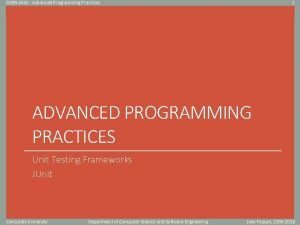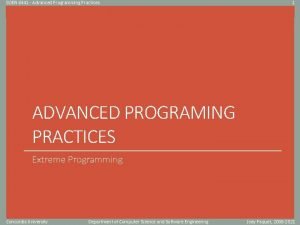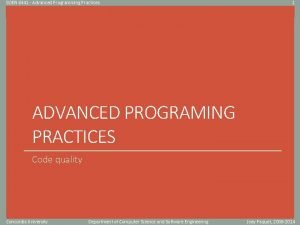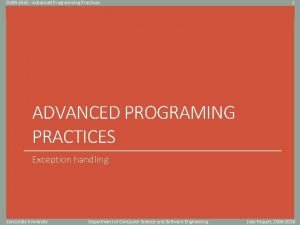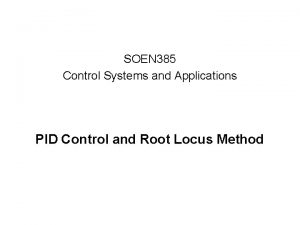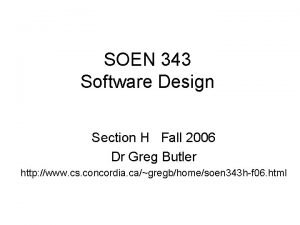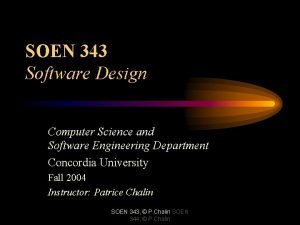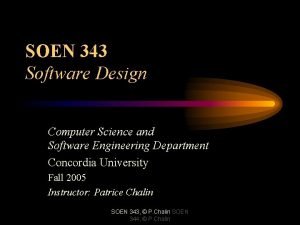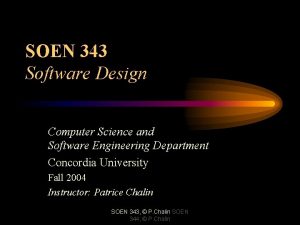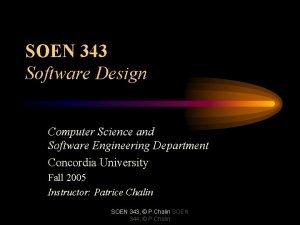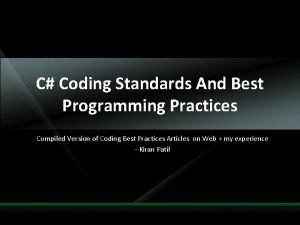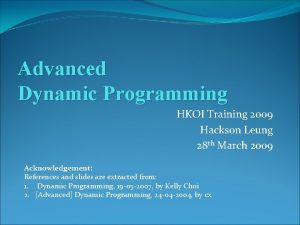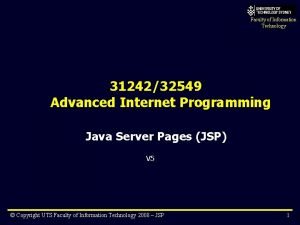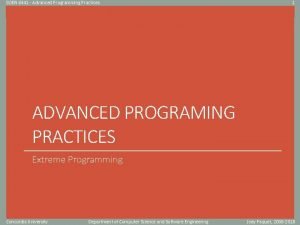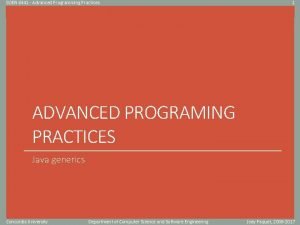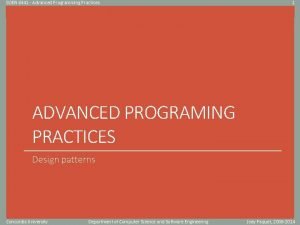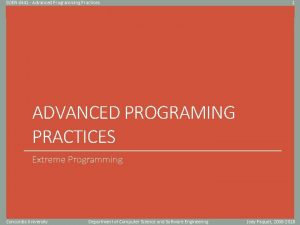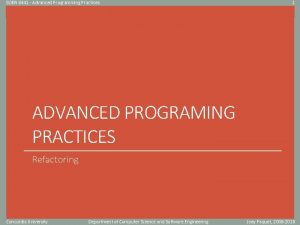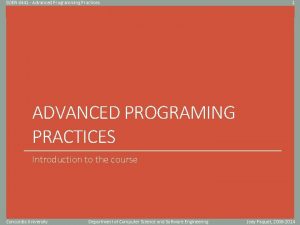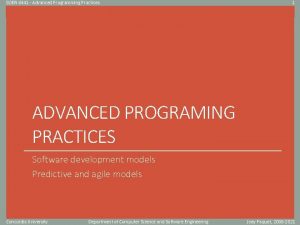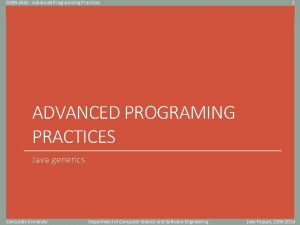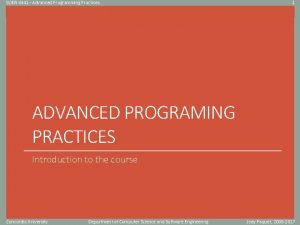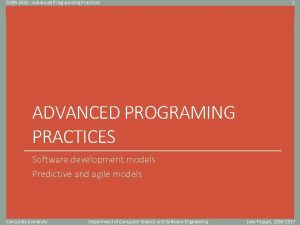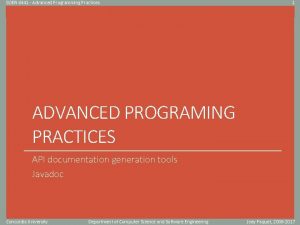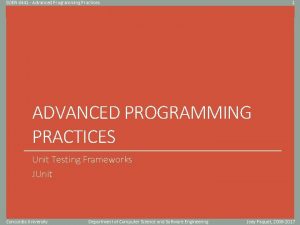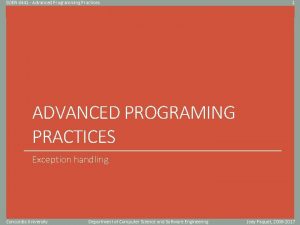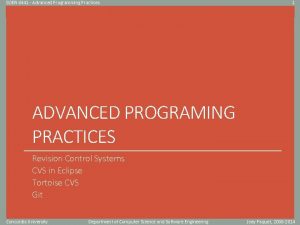SOEN 6441 Advanced Programming Practices 1 Click to



















- Slides: 19

SOEN 6441 - Advanced Programming Practices 1 Click to edit Master title style ADVANCED PROGRAMMING PRACTICES Model View Controller Architecture Observer Pattern Concordia University Department of Computer Science and Software Engineering Joey Paquet, 2007 -2021

SOEN 6441 - Advanced Programming Practices 2 Model View Controller Architecture • MVC was first introduced by Trygve Reenskaug at the Xerox Palo Alto Research Center in 1979. • Part of the basic of the Smalltalk programming environment. • Widely used for many object-oriented designs involving user interaction. • A three-tier architectural model: Concordia University Department of Computer Science and Software Engineering Joey Paquet, 2007 -2021

SOEN 6441 - Advanced Programming Practices 3 MVC: model • Model: • Manages the behavior and data of the application domain. • Responds to requests for information about its state (usually from the view). • Responds to instructions to change state (usually from the controller). • In event-driven systems, the model notifies observers (usually views) when the information changes so that they can react. (see observer pattern) • In enterprise software, a model often serves as a software approximation of a real-world process. • In a game, the model is represented by the classes defining the game entities, which are embedding their own state and actions. Concordia University Department of Computer Science and Software Engineering Joey Paquet, 2007 -2021

SOEN 6441 - Advanced Programming Practices 4 MVC: view • View: • Renders the model into a form suitable for visualization or interaction, typically a user interface element. • Multiple views can exist for a single model element for different purposes. • The view renders the contents of a portion of the model’s data. • If the model data changes, the view must update its presentation as needed. This can be achieved by using: • a push model, in which the view registers itself with the model for change notifications. (see the observer pattern) • a pull model, in which the view is responsible for calling the model when it needs to retrieve the most current data. Concordia University Department of Computer Science and Software Engineering Joey Paquet, 2007 -2021

SOEN 6441 - Advanced Programming Practices 5 MVC: controller • Controller: • Receives user input and initiates a response by making calls on appropriate model objects. • Accepts input (e. g. events or data) from the user and instructs the model to perform actions based on that input. • The controller translates the user's interactions with the view it is associated with, into actions that the model will perform that may use some additional/changed data gathered in a user-interactive view. • A controller may also spawn new views upon user demand. Concordia University Department of Computer Science and Software Engineering Joey Paquet, 2007 -2021

SOEN 6441 - Advanced Programming Practices 6 MVC: interactions between model, view and controller • Creation of a Model-View-Controller trio: 1. The model objects are created. • 2. The views register as observers on the model objects. • • 3. Any changes to the underlying data of the model objects immediately result in a broadcast change notification, which all associated views receive (in the push model). Note that the model is not aware of the view or the controller -- it simply broadcasts change notifications to all registered observers. The controller is bound to a view. • • 4. Each model object represents a portion of the business model state held by the application. It can then react to any user interaction provided by this view. Any user actions that are performed on the view will invoke a method in the controller class. The controller is given a reference to the underlying model. • Concordia University It can then trigger the model’s behavior functions and/or state change when one of its methods is called. Department of Computer Science and Software Engineering Joey Paquet, 2007 -2021

SOEN 6441 - Advanced Programming Practices 7 MVC: interactions between model, view and controller • Once a user interacts with the view, the following actions occur: 1. The view recognizes that a GUI action -- for example, pushing a button or dragging a scroll bar -- has occurred, e. g using a listener method that is registered to be called when such an action occurs. The mechanism varies depending on the technology or library used. 2. In the listener method, the view calls the appropriate method in the controller. 3. The controller translates this signal into an appropriate action in the model, which will in turn possibly be updated in a way appropriate to the user's action. 4. If the state of some of the model’s elements have been altered, they then notify registered observers of the change. In some architectures, the controller may also be responsible for updating the view. Again, technical details may vary according to technology or library used. Concordia University Department of Computer Science and Software Engineering Joey Paquet, 2007 -2021

SOEN 6441 - Advanced Programming Practices 8 Click to edit Master title style Observer pattern Concordia University Department of Computer Science and Software Engineering Joey Paquet, 2007 -2021

SOEN 6441 - Advanced Programming Practices 9 Observer pattern: motivation, intent • Motivation • The cases when certain objects need to be informed about the changes occurring in other objects are frequent. To have a good design means to decouple as much as possible and to reduce the dependencies. The Observer Design Pattern can be used whenever a subject has to be observed by one or more observers. • Intent • Define a one-to-many dependency between objects so that when one object changes state, all its dependents are notified and updated automatically. • This pattern is a cornerstone of the Model-View-Controller architectural design, where the Model implements the business logic of the program, and the Views are implemented as Observers that are as much uncoupled as possible from the Model components. Concordia University Department of Computer Science and Software Engineering Joey Paquet, 2007 -2021

SOEN 6441 - Advanced Programming Practices 10 Observer pattern: design “View” classes “Model” classes Concordia University Department of Computer Science and Software Engineering Joey Paquet, 2007 -2021

SOEN 6441 - Advanced Programming Practices 11 Observer pattern: design • The participants classes in the Observer pattern are: • Subject - interface or abstract class defining the operations for attaching and de-attaching observers to the client. It is often referred to as “Observable”. • Concrete. Subject - concrete Subject class. It maintains the state of the observed object and when a change in its state occurs it notifies the attached Observers. If used as part of MVC, the Concrete. Subject classes are the Model classes that have Views attached to them. • Observer - interface or abstract class defining the operations to be used to notify the registered Observer objects. • Concrete. Observer - concrete Observer subclasses that are attached to a particular Subject class. There may be different concrete observers attached to a single Subject that will provide a different view of that Subject. Concordia University Department of Computer Science and Software Engineering Joey Paquet, 2007 -2021

SOEN 6441 - Advanced Programming Practices 12 Observer pattern: behavior • Behavior • The client class instantiates the Concrete. Observable object. • Then it instantiates and attaches the concrete observers to it using the methods defined in the Observable interface. • Each time the (observable) state of the subject is changing, it notifies all the attached Observers using the methods defined in the Observer interface. • When a new Observer is added to the application, all we need to do is to instantiate it in the client class and to add attach it to the Observable object. • The classes already created will remain mostly unchanged. Concordia University Department of Computer Science and Software Engineering Joey Paquet, 2007 -2021

SOEN 6441 - Advanced Programming Practices 13 Observer pattern: implementation /** * Interface class for the Observer, which forces all views to implement the * update method. */ public interface Observer { /** * method to be implemented that reacts to the notification generally by * interrogating the model object and displaying its newly updated state. * * @param o: Object that is passed by the subject (observable). Very often, this * object is the subject itself, but not necessarily. */ public void update(Observable p_observable_state); } • Observer is an interface (it may also be an abstract class). • Declares a method update() that is used polymorphically. • All classes implementing this interface it must then override this method. Concordia University Department of Computer Science and Software Engineering Joey Paquet, 2007 -2021

SOEN 6441 - Advanced Programming Practices 14 Observer pattern: implementation /** * Class that implements the connection/disconnection mechanism between * observers and observables (subject). It also implements the notification * mechanism that the observable will trigger when its state changes. */ public class Observable { private List<Observer> observers = new Array. List<Observer>(); /** * attach a view to the model. * @param p_o: view to be added to the list of observers to be notified. */ public void attach(Observer p_o) { this. observers. add(p_o); } /** * detach a view from the model. * @param p_o: view to be removed from the list of observers. */ public void detach(Observer p_o) { if (!observers. is. Empty()) { observers. remove(p_o); } } /** * Notify all the views attached to the model. * @param p_o: object that contains the information to be observed. */ public void notify. Observers(Observable p_o) { for (Observer observer : observers) { observer. update(p_o); } } } Concordia University Department of Computer Science and Software Engineering • The Observable base class is providing the implementation of the notification mechanism, including the attach/detach mechanism. Joey Paquet, 2007 -2021

SOEN 6441 - Advanced Programming Practices 15 Observer pattern: implementation class Clock. Timer. Model extends Observable { private int int • The Model classes implement the business model of the implementation. hour; minute; second; timed. Interval; public int get. Hour() {return hour; }; public int get. Minute() {return minute; }; public int get. Second() {return second; }; public void tick() { second++; if (second >= 60) { minute++; second = 0; if (minute >= 60) { hour++; minute = 0; if (hour >= 24) { hour = 0; }; }; }; notify. Observers(this); }; • In order to be made Concrete. Observable classes, they have to: • Inherit the attach/detach and notification mechanisms from the Observable class. • Notify their Observers when an observable part their state changes. public void start() { for (int i = 1; i <= timed. Interval; i++) tick(); }; public void set. Time(int h, int m, int s) { hour = h; minute = m; second = s; notify. Observers(this); } public void set. Timed. Interval(int t) { timed. Interval = t; } }; Concordia University Department of Computer Science and Software Engineering Joey Paquet, 2007 -2021

SOEN 6441 - Advanced Programming Practices 16 Observer pattern: implementation /** * This is the View class of the MVC trio for the clock * timer example. */ class Digital. Clock. View implements Observer { /** * Constructor that attaches the model to the view. * * @param clock. Model */ public Digital. Clock. View(Clock. Timer. Model p_clock. Model) { p_clock. Model. attach(this); } /** * Display the new hour, minute, second of the clock after * the view has been notified of a state change in the model. * * @param obs: object that contains the displayed information * @return none */ public void update(Observable p_o) { int hour = ((Clock. Timer. Model) p_o). get. Hour(); int minute = ((Clock. Timer. Model) p_o). get. Minute(); int second = ((Clock. Timer. Model) p_o). get. Second(); System. out. println(hour + ": " + minute + ": " + second); }; • The View classes implement the displaying of information relevant to the user from Model objects. • In order to be made Concrete. Observer classes, they have to: • Implement the Observer interface. • Implement the update() method declared in the Observer interface. }; Concordia University Department of Computer Science and Software Engineering Joey Paquet, 2007 -2021

SOEN 6441 - Advanced Programming Practices 17 Controller: implementation • The Controller classes public class Clock. Controller { private Digital. Clock. View clock. View; private Clock. Timer. Model clock. Model; public Clock. Controller(Digital. Clock. View p_view, Clock. Timer. Model p_model) { clock. View = p_view; clock. Model = p_model; } public void control. Clock() { Scanner kbd = new Scanner(System. in); while (true) { System. out. println("1. Set the timer's start time (1 int int <return>)"); System. out. println("2. Set the timer's timed interval (2 int <return>)"); System. out. println("3. Start the timer (3 <return>)"); System. out. println("4. Exit (4 <return>)"); System. out. print("Enter action (1, 2, 3, 4) : "); int command = kbd. next. Int(); switch (command) { case 1: int h, m, s; h = kbd. next. Int(); m = kbd. next. Int(); s = kbd. next. Int(); clock. Model. set. Time(h, m, s); break; case 2: int t; t = kbd. next. Int(); clock. Model. set. Timed. Interval(t); break; case 3: clock. Model. start(); break; case 4: kbd. close(); System. out. println("Clock timer shutting down"); return; } } }; } Concordia University implement the control flow involved between the operation of the Model object and the View object • In this example’s case: • Interact with the user to get their input used to set the clock’s operation. • Trigger some methods of the clock to trigger the clock’s operation. • In this example, the controller does not interact with the View. In most cases, the Controller does interact with the View. Department of Computer Science and Software Engineering Joey Paquet, 2007 -2021

SOEN 6441 - Advanced Programming Practices 18 MVC: putting it all together public class MVCDemo extends Object { private Digital. Clock. View clock. View; private Clock. Timer. Model clock. Model; private Clock. Controller clock. Controller; public MVCDemo() { clock. Model = new Clock. Timer. Model(); clock. View = new Digital. Clock. View(clock. Model); clock. Controller = new Clock. Controller(clock. View, clock. Model); }; public static void main(String[] av) { MVCDemo od = new MVCDemo(); od. demo(); }; public void demo() { clock. Controller. control. Clock(); clock. Model. detach(clock. View); }; • In this example, the Model/View/Controller objects are created and connected for the entire duration of the program’s lifetime. • Depending on the application, some Views/Controllers may be created/removed by user actions. }; Concordia University Department of Computer Science and Software Engineering Joey Paquet, 2007 -2021

SOEN 6441 - Advanced Programming Practices 19 References • OODesign. com. Observer Pattern. • Erich Gamma, Richard Helm, Ralph Johnson and John Vlissides, Design Patterns – Elements of Reusable Object-Oriented Software, Addison-Wesley, 1995. Concordia University Department of Computer Science and Software Engineering Joey Paquet, 2007 -2021
 Soen 6441
Soen 6441 Soen 6441
Soen 6441 Soen 6441
Soen 6441 Soen 6441 concordia
Soen 6441 concordia Cyber safety
Cyber safety Clever click
Clever click Click clever click safe
Click clever click safe Click clever click safe
Click clever click safe Soen 385
Soen 385 Soen 342
Soen 342 Soen 385
Soen 385 Soen 343
Soen 343 Soen 343
Soen 343 Soen 343
Soen 343 Best programming practices
Best programming practices An imperative statement in system programming
An imperative statement in system programming Advanced assembler directives in system programming
Advanced assembler directives in system programming Dynamic programming bottom up
Dynamic programming bottom up Advanced programming in java
Advanced programming in java Advanced internet programming
Advanced internet programming
